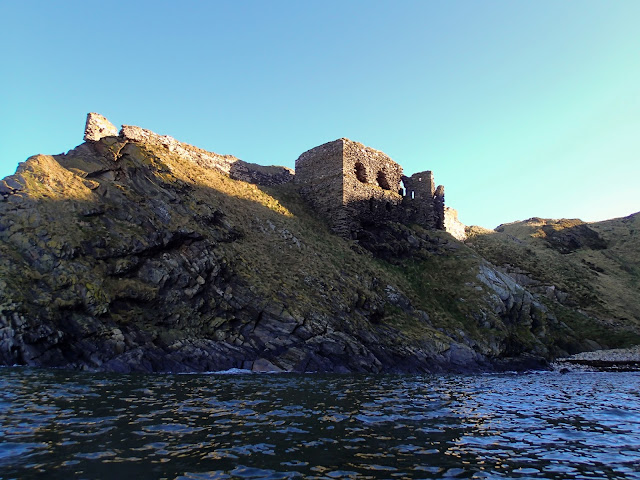My eye kept coming back to Clachnaben - the hill sort of chose itself. My previous climbs had both been from the north, so I looked for a different route and worked out a circuit that would work with, rather than against the wind.
A small quarried area off the B974 (the Banchory to Fettercairn road over the Cairn o' Mount, which on this day was closed higher up due to snow) has been made into a parking area from where the shortest route to Clachnaben starts. The first part of the walk rises gently through open woodland and was very pleasant with sunlight dappling the woodland floor.
Emerging from the wood there's the sudden "reveal" of Clachnaben ahead. The granite tor which forms the true summit is very prominent from miles around, particularly as the hill sits in isolation at the end of a ridge above the lower ground of the Dee valley. Sheltered from the strong northwest wind, and with views like this, it was a superb morning to be out.
My route diverged from the "normal" path to the summit and continued around the slopes of Netty Hill into Glen Dye. The view down to the Water of Dye was an unexpected delight, and would make a great short walk by itself. A quicker way to this point is by parking near to the narrow road bridge at Spital of Glen Dye, but parking is limited, and on a difficult bend.
The ground was so frozen that I'd put two sets of boots in the car, plus crampons. On looking at conditions on the drive over I'd opted not to use my heavy boots and crampons. This was the right choice for the hill, but further along the Glen Dye track I was wishing for a third option....ice skates! The whole track was covered in thick blue-grey ice...there aren't any photographs from this part of the walk as I concentrated on staying upright.
I managed to reach Charr with only one or two "skitey" moments, one of which had me doing a fair impression of Bambi on Ice.......
Charr is now an MBA bothy, and sits in a wild and lonely place; it seems much more isolated than the distance from the road would suggest.
The bothy occupies three rooms in part of the building, the remainder is retained by Fasque estate. There's no fire or stove here but the place is clean, dry and bright. I've visited previously but not (yet) stayed here. I met another walker heading home to Fettercairn over the hills having been dropped at Spital, Charr is on a number of potential routes between Deeside, the Mearns and the Angus glens - which is food for thought for future walks.
After lunch and a "brew" of tea in the bothy ("Char" at Charr?!) I headed back out and tackled the steep climb up the track beside the Bracky Burn. Emerging onto the open hill at the top exposed me to the wind, which was absolutely biting. This was the only leg of the walk where I'd be heading into the wind; I'd planned the route to have it with me on the high ridge leading to Clachnaben.
To the west there's a wonderful view of wild, open country with the higer hills leading to the Cairngorm plateau beyond. It is, essentially, a view of absolutely nothing - and that's a precious thing. There's word that a windfarm is planned near here with giant turbines; if the planning application goes ahead I will be objecting - this is a landscape which shouldn't be industrialised.
The climbing continues to meet a track between Mount Battock and Clachnaben, where I was really glad to turn and put the wind from my starboard bow to my port quarter, it was searingly cold as well as strong. Clachnaben's tor is well seen from here, but the view is of the shorter side rather than the full height. The ground on this ridge is bare and broken, and marked by ATV tracks - it's better under snow than not for this reason.
This is one of the hills where the trig point isn't the actual summit. The scramble up onto the tor is easy in most circumstances but with a combination of ice and the gusting wind I elected not to stand up on the very top block!
On te direct descent (which is the usual ascent path) the tor is seen at its best. A granite plug, the tor has been plucked by ice and from most angles appears as a "wart" on the slope of the ridge.
Away to the north there's a good view of that other much loved Aberdeenshire landmark, Bennachie. The distinctive shapes and proximity to the coast of these two fine hills gives rise to the old rhyme :
"Clachnaben and Bennachie, are twa landmarks frae the sea"
On the way back down Clachnaben this set me thinking - would it be possible to climb both hills in a day using a bike to get between them? A long day for sure, but just maybe......
My circular route was 16 kilometres with around 500 metres of ascent. I took a little over four and a half hours including a brief stop at Charr bothy. Other circular routes are possible from the north which can take in Mount Battock and the connecting ridge. The shortest route is a simpe up-and-down from the B974, but in my opinion this fine hill deserves more than that.





























